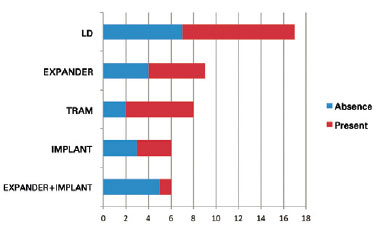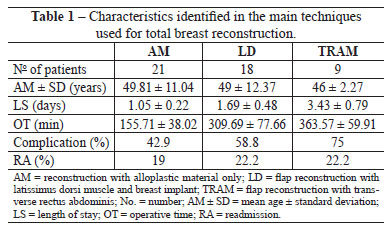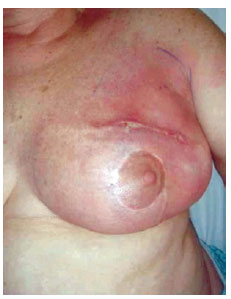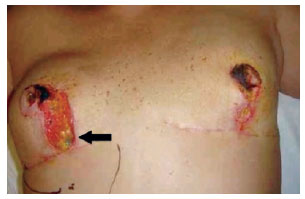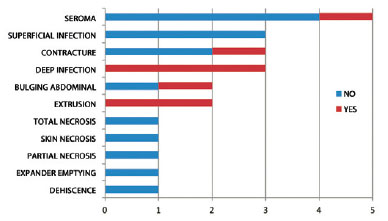ABSTRACT
INTRODUCTION: Some techniques for total reconstruction of the breast, regardless of complexity, present specific complications, with varying degrees of morbidity. Therefore, the aim of this study was to identify the most frequent complications of the main techniques used for breast reconstruction, and to compare these complications to the relevant independent variables.
METHODS: This cross-sectional observational study was conducted by reviewing the medical records of patients who had their breasts completely rebuilt after a mastectomy due to breast cancer from January 2007 to December 2009, with a minimum postoperative follow-up of 3 years. The data collected, such as the timing of the intervention, reconstruction techniques, operative time, and adjuvant treatment, were statistically related to the presence of complications.
RESULTS: Of the 48 total breast reconstructions analyzed, the technique in which expanders were used followed by replacement with implants showed the lowest prevalence of complications (16.7%, P < 0.000). Some techniques showed specific complications. The operative time for transplantation of transverse rectus abdominis musculocutaneous flap (363.57 ± 59.91 min) was significantly higher than that required for techniques using alloplastic materials (155.71 ± 38.02 min, P = 0.01), but similar to that for the latissimus dorsi flap (309.69 ± 77.66 min). The operative time, timing of surgical intervention, and type of adjuvant treatment did not correlate with the incidence of complications.
CONCLUSIONS: Each technique has its indications, contraindications, and complications. The application of each technique should be individualized on the basis of the individual characteristics of the patient to obtain better results, avoiding short- and long-term complications.
Keywords:
Breast/surgery. Breast implantation. Mammaplasty/complications. Postoperative complications.
RESUMO
INTRODUÇÃO: Algumas técnicas de reconstrução total de mama, independentemente de sua complexidade, apresentam complicações específicas, com diferentes graus de morbidade. Com base nessas informações, o objetivo deste estudo foi identificar as complicações mais frequentes apresentadas pelas principais técnicas de reconstrução mamária e compará-las a relevantes variáveis independentes.
MÉTODO: Estudo observacional tipo coorte transversal, realizado por meio de revisão de prontuários médicos de pacientes que tiveram suas mamas totalmente reconstruídas após mastectomia por câncer de mama, no período de janeiro de 2007 a dezembro de 2009, com tempo mínimo de seguimento pós-operatório de 3 anos. Os dados coletados, como momento da intervenção, técnicas de reconstrução, tempo de cirurgia e tratamento adjuvante, foram estatisticamente relacionados à presença de complicações.
RESULTADOS: Das 48 reconstruções mamárias totais analisadas, a técnica com expansor seguido pela troca por implante mamário foi a que apresentou menor prevalência de complicação em relação às outras técnicas (16,7%; P < 0,000). Algumas técnicas apresentaram complicações específicas. O tempo cirúrgico do retalho transverso do músculo reto abdominal (TRAM; 363,57 ± 59,91 minutos) foi significativamente maior que das técnicas com materiais aloplásticos (155,71 ± 38,02 minutos; P = 0,01), mas semelhante ao do grande dorsal (309,69 ± 77,66 minutos). O tempo de cirurgia, o momento da intervenção cirúrgica e o tipo de tratamento adjuvante não apresentaram relação com a incidência de complicações.
CONCLUSÕES: Cada técnica empregada tem sua indicação, contraindicação e complicação e a aplicação de cada técnica deve ser individualizada, baseando-se em características individuais da paciente, a fim de se obter um melhor resultado, evitando complicações a curto e longo prazos.
Palavras-chave:
Mama/cirurgia. Implante mamário. Mamoplastia/complicações. Complicações pós-operatórias.


